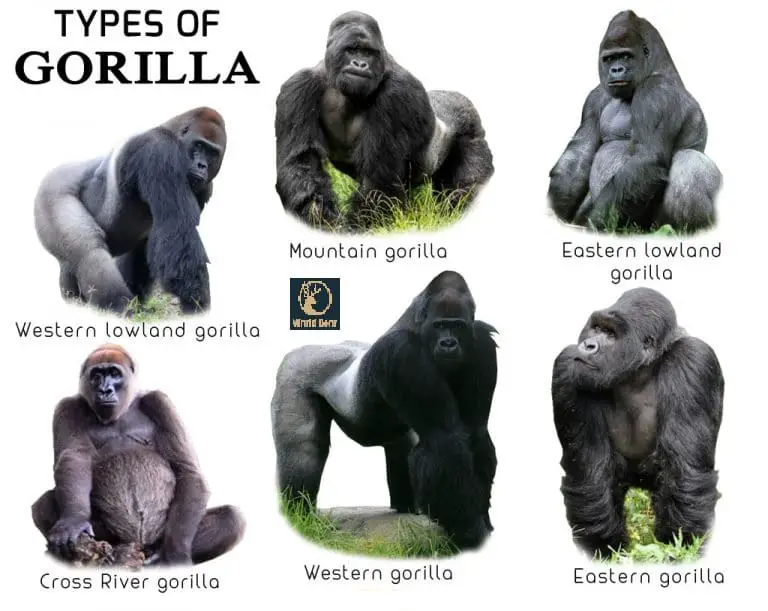GORILLAS
Oh! It’s a gorilla. An intelligent primate belongs to the same family Hominidae as humans and chimpanzees. Primates are an order of the class Mammalia distinguished by large brains, complex behavior, and free movement of shoulder joints.
Gorillas are cousins of humans as they share 98% of their genetic code with humans. They are very shy and non-aggressive, unlike those provoked by humans.
Scientific Classification of Gorillas
Kingdom | Animalia |
Phylum | Chordata |
Class | Mammalia |
Order | Primates |
Family | Hominidae |
Genus | Gorilla |
Types of Gorilla
Two species of gorilla fall under the genus Gorilla. These two species further consist of 4 subspecies.
Western Gorilla
- Cross River Gorilla: It is the rarest type of gorilla found in the rainforests of Nigeria and Cameroon, with only 300 left.
- Western Lowland Gorilla: It is the most abundant among all types of gorillas but is also listed as endangered.
Eastern Gorilla
- Mountain Gorilla: There are only 880 individuals left, and they are listed as endangered.
- Eastern Lowland gorillas: Like other subspecies, they are also critically endangered.

Description
Size and Weight: 4 to 5 feet in height. Females are 86 to 97 kg in weight while males have 36 to 220 kg of body weight.
Dentition: They have 32 teeth, the same as humans. They have very strong teeth. During their lifetime, they have two full sets of teeth, the first being baby teeth, which permanent ones replace as in humans.
Speed: 40 km per hour
Body and Coloration: It’s a large-bodied animal with dark skin and brown or grey hairs. Though their face is hairless, they have a broad chest and shoulders, a bulging head, and a sagittal crest on top. In males, a silver color appears on the back at sexual maturity, called silverback. Gorillas don’t have tails like monkeys.
Arms and Limbs: Arms are much longer than hind limbs. Nature designed them in a way to gather foliage and for defense. They can walk upright like humans and also walk quadrupled like other animals.
Distribution and Habitat
Gorillas are found only in the continent of Africa. The western gorilla lives in west central Africa, while the eastern gorilla lives in east central Africa. Gorillas live in a variety of habitats such as tropical rainforests, swamplands, and montane forests. Montane refers to the slope of mountains.
- Western lowland gorillas live in the tropical forests of the Central African Republic, Congo, Cameroon, Gabon, and Guinea.
- The Cross river Gorilla lives across the border of Nigeria and Congo.
- The eastern lowland gorilla lives in the tropical forests of the eastern democratic republic of Congo.
- The mountain gorillas live in elevations and in tropical forests in Rwanda, Uganda and Zaire.
Diet and Foraging
Gorillas are herbivores. Herbivores are animals that feed mostly on vegetation but sometimes eat invertebrates during feeding. They preferred to eat foliage such as stems, leaves, shoots, and fruits, as well as ants and termites. An adult male eats up to 18 kilograms (40 pounds) of food per day.
- Western Gorilla’s diet comprises 67% of fruit, 17% leaves and stems, and only 3% termites and caterpillars.
- The eastern gorilla diet comprises 86% leaves and shoots, 7% roots, 3% flowers, only 2% fruits, and 2% ants and snails. There is a lower fruit percentage due to the small presence of fruits in the mountains.
Gorillas show very selective foraging behavior. They crop the vegetation and just consume the particular portion they want. They don’t overuse the food area. They vegetate in a particular manner. Gorillas don’t drink much water in the wild because the food they eat balances their hydration level.
Behavioral Adaptations
Social behavior
Groups of gorillas are called troops. A troop may often contain 6 to 30 members. It’s a complete family group, just like humans. Members included are Silverback and its sons, females, infants, juveniles(called blackbacks), and young. Females come from other troops to breed with them. The infants are the offspring of young adults.
Silverback is the head of the troop. He makes all group decisions and is responsible for food and protection. He is just like a human father who ends any disobedience with just a look. There may be more than one silverback in a troop who leads the troop after the death of the elder silverback.
Knuckling
Gorillas are called knuckle walkers as they walk on their knuckles. The knuckle is the part where the finger joins the hand. Chimpanzees share this knuckling behavior with gorillas.
Communication
Gorillas may show twenty to twenty-five varied sounds for communication, but there is no identifiable language like that of humans. They do grunting and bark to communicate among troops while travelling. For alarming, screams and roars are often heard by silverbacks.
Defensive behavior
Gorillas are peaceful primates. They resolve their conflicts without becoming physical. What’s the need to fight when the display works better? The display includes chest-beating, tearing and throwing vegetation, bipedal rising, one leg kick, and,at last, thumping the ground to end the display.
Intelligence
Great apes and gorillas are very intelligent creatures that use tools in their life activities. They use sticks to measure river depth and twigs to scoop up their food. They make ladders with bamboo, so their young can climb trees. They are rich in emotions and make strong family bonds. They are using sign language. They recognize themselves in a mirror which only a few non-humans can do.
Reproduction and Parenting
Gorillas are polygamous because silverbacks mate with different females. Breeding rights are given to the dominant silverback. Female gorillas become sexually mature at the age of 8 to 10 years. However, it starts breeding after 2 years. Males become sexually mature at the age of 11 to 13 years. Females breed once in three to four years.
The gestation period lasts for 8.5 to 9 months. Infants are totally dependent on their mothers for about five months. Silverbacks and other males are supportive of protecting young ones. A 3-year gorilla enters its juvenile period and starts sleeping in separate nests from its mother. After 6 years, it becomes young. A female gets pregnant after her offspring becomes young.
Role in the ecosystem
Gorillas play an important role in maintaining the biodiversity in forests, simply their homes. During foraging, they disperse seeds of plants they eat and make small gaps in trees to open up and find sunlight for thriving. Nature created these large grazers to balance the ecosystem. They act as “umbrella species,” eat a lot of vegetation, and avoid disrupting the food chain.
Mortality Rate and Lifespan
In the wild, an adult gorilla may live up to 35 years. Their lifespan may extend to 50 years. The mortality rate is high in infants. The adult mortality rate is 5%.
Death cause: Physical trauma is a major cause that humans can induce. In mountain gorillas, it may be due to accidents or caused by other gorillas.
Humans are threats
There are no natural predators for gorillas except leopards and crocodiles. Humans are the greatest threat to all gorillas because they hunt them for food, called Bushmeat, and for logging. They are declining their natural habitats through farming, logging, and mining. They capture gorillas for trophies and display them in zoos to enhance tourism and to attract tourists. There is a continuous decline in the gorilla population.
Diseases
The same diseases mostly infect gorillas and other primates as humans. Hepatitis A, poliovirus, tapeworm, and tuberculosis bacillus. The disease-causing agents come from fecal-tainted soil for up to six months. At the end of 2002, there was an Ebola virus that caused the deaths of gorillas and chimpanzees in a large number. It has also been observed that gorillas in captivity were affected by the Coronavirus.
Conservation Status and Efforts
According to the International Union of Conservation of Nature (IUCN), gorilla species are listed as Critically Endangered species. Now, there are about 316,000 western lowland gorillas that exist in the wild, and 4000 in zoos. Five thousand eastern lowland gorillas are found in the wild, while 25 are in zoos. It’s all possible with the ongoing conservation efforts for gorillas.
The Gorilla Agreement is a legal step toward gorilla conservation, but consumers, traders, and poachers still book their profits by relying on gorillas. It all happened due to weak law enforcement.
Cultural value
In many African tribes, gorillas are the symbols of strength and protection. In African folk stories, they are featured as noble and intelligent characters. Gorillas are linked to authority, generosity, and honor throughout the world.
Hollywood films like King Kong, The Gorilla, and many others featured gorillas as monsters, but in reality, gorillas are very shy and relatively nonaggressive animals except in fewer situations. They are also characterized as enemies against superheroes like Tarzan and Sheena Queen.
Interesting Facts
- Gorillas show affection by displaying nose-to-nose touching posture.
- Although their heads are large, their brains are smaller than humans.
- Wrestling is a part of the play between gorillas.
- Their nose prints are unique and significant from each other, just like human fingerprints.
- A fully grown silverback is stronger than 20 adult humans combined.
Frequently Asked Questions About Gorillas
Q- What are 3 characteristics of gorillas?
Gorillas have a large, muscular build, dark skin covered with brown or grey hair, and expressive brown eyes. They are also known for their gentle nature and strong family bonds.
Q- What is the speciality of gorilla?
Gorillas are incredibly intelligent and share 98% of their DNA with humans. They use tools, recognize themselves in mirrors, and can even learn basic sign language.
Q- Why is gorilla called gorilla?
The name “gorilla” comes from the Greek word “gorillai,” meaning “tribe of hairy women,” a term used by explorers to describe the species they encountered.
Q- What does a gorilla eat?
Gorillas are herbivores, primarily eating leaves, stems, fruits, and occasionally insects like ants and termites.
Q- Is gorilla good or bad?
Gorillas are neither good nor bad. They are gentle, intelligent animals that play a crucial role in their ecosystems by dispersing seeds and maintaining forest health.
Q- Is gorilla friendly to humans?
Gorillas are generally shy and non-aggressive towards humans. However, it’s important to respect their space and not provoke them.
Q- What is gorilla afraid of?
Gorillas are naturally wary of large predators like leopards and humans. They also avoid unknown objects and loud noises.
Q- What is a gorilla’s worst enemy?
Humans are the greatest threat to gorillas due to habitat destruction, poaching, and disease transmission.
Q- How old is the oldest gorilla?
The oldest known gorilla in captivity is Fatou, who turned 65 in 2022.
Q- Can a gorilla beat a lion?
While gorillas are strong, they generally avoid confrontations. A fight between a gorilla and a lion would depend on many factors, and it’s not a typical scenario in nature.
Q- What angers a gorilla?
Gorillas can become angry when they feel threatened or if their group is disturbed. They show anger through chest-beating, roaring, and tearing vegetation.
Q- How does a gorilla cry?
Gorillas don’t cry like humans, but they make various sounds to express emotions, such as whimpers, grunts, and roars.
Q- Are gorillas peaceful?
Yes, gorillas are generally peaceful animals. They prefer to resolve conflicts through displays and vocalizations rather than physical fights.
Q- Can you touch a gorilla?
It’s not advisable to touch a gorilla in the wild or in captivity as it can be stressful for the animal and dangerous for humans.
Q- Can I smile at a gorilla?
Smiling at a gorilla can be interpreted as a sign of aggression due to the baring of teeth. It’s best to avoid direct eye contact and smiling.
Q- Can gorillas accept humans?
Wild gorillas can become habituated to human presence through careful and respectful practices, but they remain wild animals.
Q- Can a gorilla become a pet?
Gorillas are wild animals and not suitable as pets. They require specific habitats, diets, and social structures to thrive.
Q- Can a gorilla be a female?
Yes, gorillas can be female. Female gorillas play a crucial role in the social structure of their groups and in raising offspring.
Q- Can a gorilla lift a human?
Yes, a gorilla’s strength is immense, and they can easily lift the weight of a human.
Q- Do gorillas recognize humans?
Gorillas can recognize individual humans, especially those they interact with regularly, such as caretakers or researchers.
Q- What do gorillas eat?
Gorillas eat a variety of vegetation, including leaves, stems, fruits, and occasionally insects like ants and termites.
Can gorillas speak human language?
Gorillas can’t speak human language, but they can learn basic sign language and use gestures to communicate.
Q- Are gorillas intelligent?
Yes, gorillas are highly intelligent, capable of using tools, solving problems, and displaying complex emotions.
Q- Are gorillas 99% human?
Gorillas share about 98% of their DNA with humans, making them one of our closest relatives.
Q- What is a female gorilla called?
A female gorilla is simply called a female gorilla. There is no special term distinguishing female gorillas from males, aside from “female” or “mother.”
Learn More About Gorillas
On this page, you are invited to browse our articles about the fascinating behaviors of gorillas.
These articles answer common questions about gorillas, including what they eat, when they’re most active, their reproductive cycles, and how they interact with humans in various environments.
Scroll down to learn more about the unique behaviors of gorillas and discover why they act the way they do.

Can Gorillas Swim?
Can Gorillas Swim? No, gorillas cannot swim. They lack the natural ability to swim and they tend to avoid deep

Do Gorillas Use Tools?
Do Gorillas Use Tools? Yes, gorillas do use tools. They have been observed using sticks, rocks, and other natural materials

How Do Gorillas Adapt to Their Environment?
Physical Adaptations of Gorillas Gorillas have evolved several physical adaptations that help them thrive in their environment. One of the

How Do Gorillas Care for Their Young?
Introduction: How Gorillas Care for Their Young Gorillas show remarkable care for their young through nurturing and protective behaviors. Just

How Do Gorillas Communicate?
Introduction to Gorilla Communication When it comes to communication, gorillas are fascinating creatures capable of a wide range of vocalizations

How Do Gorillas Interact with Humans?
Gorillas and Human Interaction: An Overview Understanding how gorillas interact with humans is essential for conservation efforts and ensuring the

How Do Gorillas Mate?
How Do Gorillas Mate? Gorillas are fascinating creatures, particularly when it comes to their mating behaviors. The process of reproduction

How Do Gorillas Socialize?
Introduction to Gorillas’ Social Behavior Gorillas are highly social animals, and their interactions within groups, known as troops, are complex

How Fast Are Gorillas?
How Fast Are Gorillas? Gorillas, known for their imposing presence and remarkable intelligence, also possess surprising agility and speed. Gorillas

How Long Are Gorillas Pregnant?
How Long Are Gorillas Pregnant? The gestation period for gorillas lasts for about 8.5 to 9 months. Gorilla pregnancies are

How Long Do Gorillas Live?
How Long Do Gorillas Live in the Wild? In their natural habitat, **gorillas live on average for about 35 years**.

How Many Gorillas Are Left in the World?
Current Gorilla Population As of recent estimates, there are approximately 316,000 Western Lowland gorillas, 5,000 Eastern Lowland gorillas, 880 Mountain

How Much Do Gorillas Weigh?
How Much Do Gorillas Weigh? Adult male gorillas, called silverbacks, typically weigh around 300 to 400 pounds (136 to 181

How Smart Are Gorillas?
Gorilla Cognitive Abilities One of the most fascinating aspects of gorillas is their cognitive abilities. Gorillas are known for their

How Strong Are Gorillas?
How Strong Are Gorillas? Gorillas are known for their incredible strength, and they are often considered one of the strongest

How Tall Are Gorillas?
How Tall Are Gorillas? Gorillas typically stand between 4 to 6 feet tall when they are on their hind legs.

The Western Lowland Gorilla
Welcome to the world of Western lowland gorillas! These fascinating creatures are the most numerous and widespread of all gorilla

What Are the Conservation Efforts for Gorillas?
The Importance of Gorilla Conservation Conservation efforts for gorillas are vital to preserving biodiversity and maintaining ecological balance in their

What Are the Different Species of Gorillas?
Gorilla’s Sub Species: An In-depth Look Gorillas are divided into two main species: the Western Gorilla and the Eastern Gorilla.

What Are the Main Threats to Gorilla Populations?
Main Threats to Gorilla Populations Gorilla populations are facing significant threats that have led to their current endangered status. The

What Are the Physical Characteristics of Gorillas?
Appearance and Physical Characteristics Gorillas are robust and powerful primates with a distinct body structure that makes them one of
